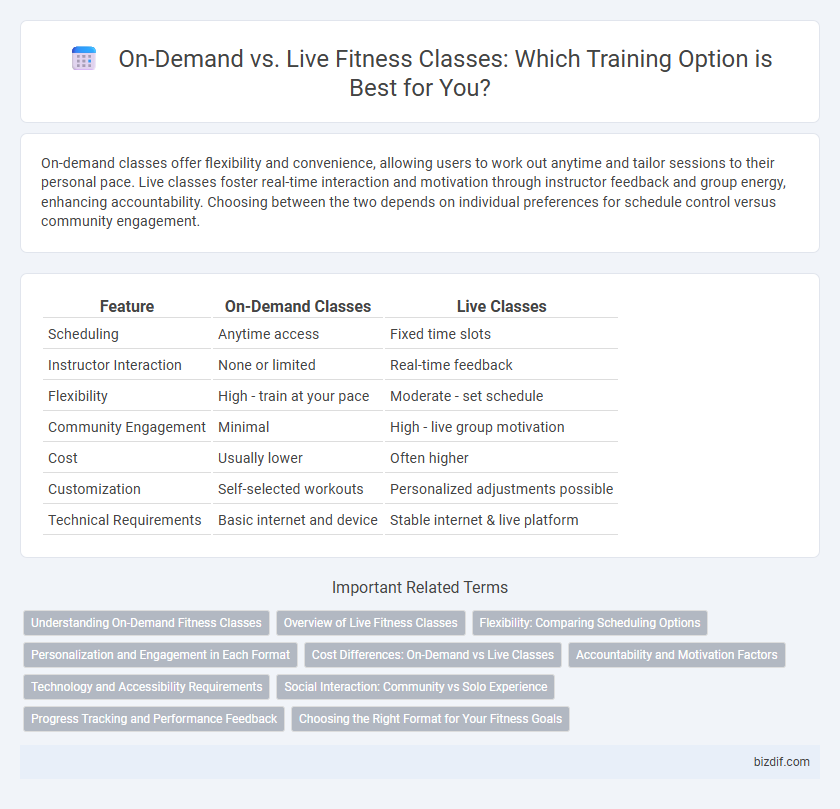On-demand classes offer flexibility and convenience, allowing users to work out anytime and tailor sessions to their personal pace. Live classes foster real-time interaction and motivation through instructor feedback and group energy, enhancing accountability. Choosing between the two depends on individual preferences for schedule control versus community engagement.
Table of Comparison
| Feature | On-Demand Classes | Live Classes |
|---|---|---|
| Scheduling | Anytime access | Fixed time slots |
| Instructor Interaction | None or limited | Real-time feedback |
| Flexibility | High - train at your pace | Moderate - set schedule |
| Community Engagement | Minimal | High - live group motivation |
| Cost | Usually lower | Often higher |
| Customization | Self-selected workouts | Personalized adjustments possible |
| Technical Requirements | Basic internet and device | Stable internet & live platform |
Understanding On-Demand Fitness Classes
On-demand fitness classes provide flexible access to a wide variety of workouts anytime, allowing users to tailor their schedules without the constraints of fixed class times. These classes often include detailed video instructions and progress tracking features, enabling personalized pacing and repeated practice of complex movements. Unlike live sessions, on-demand options offer convenience and customization, making them ideal for individuals seeking consistent training without synchronous participation.
Overview of Live Fitness Classes
Live fitness classes offer real-time interaction with instructors, fostering immediate feedback and personalized adjustments to form and technique. These sessions create a motivating group environment, enhancing accountability and encouraging consistent participation. The dynamic, scheduled nature of live classes helps users stay committed to their fitness goals through structured routines and communal support.
Flexibility: Comparing Scheduling Options
On-demand fitness classes offer unparalleled flexibility by allowing users to access workouts anytime, accommodating varying schedules and time zones. Live classes provide structured timing with real-time instructor interaction, fostering accountability and motivation during fixed sessions. Choosing between on-demand and live formats depends on personal preferences for schedule control versus interactive engagement.
Personalization and Engagement in Each Format
On-demand fitness classes offer personalized workout plans tailored to individual goals, allowing users to exercise at their own pace and schedule, enhancing convenience but often reducing real-time interaction. Live classes foster higher engagement through direct instructor feedback, community motivation, and the ability to modify routines instantly based on participant performance. Both formats cater to different personalization needs, with on-demand excelling in flexibility and live sessions driving motivation and immediate adjustments.
Cost Differences: On-Demand vs Live Classes
On-demand fitness classes typically offer a lower cost option due to the absence of real-time instructor interaction and the ability to reuse content for multiple users. Live classes often command higher prices, reflecting the personalized guidance, motivation, and immediate feedback provided during the session. Evaluating cost differences involves considering subscription fees for on-demand access versus per-class or membership fees for live sessions, with live classes generally representing a premium investment in fitness training.
Accountability and Motivation Factors
On-demand fitness classes offer flexibility but often lack the real-time accountability that live classes provide, which can impact motivation levels. Live classes create a sense of community and immediate feedback from instructors, helping participants stay committed and driven. Personalized interaction during live sessions enhances motivation by fostering accountability and encouraging consistent attendance.
Technology and Accessibility Requirements
On-demand fitness classes leverage streaming technology to offer unparalleled accessibility, enabling users to exercise anytime on smartphones, tablets, or smart TVs without scheduling constraints. Live classes require stable, high-speed internet and compatible devices to support real-time interaction, often demanding specific video conferencing platforms like Zoom or Microsoft Teams. Both formats benefit from advancements in app integration and wearable technology, enhancing personalized workout tracking and user engagement.
Social Interaction: Community vs Solo Experience
On-demand fitness classes offer a solo experience, allowing users to work out at their own pace without real-time interaction, ideal for those who prefer flexibility and privacy. Live classes foster a sense of community through real-time engagement, enabling participants to connect with instructors and peers, enhancing motivation and accountability. Social interaction in live classes contributes to a supportive environment, boosting commitment and overall workout satisfaction.
Progress Tracking and Performance Feedback
On-demand fitness classes offer flexible progress tracking through integrated app metrics, enabling users to review past workouts and monitor improvements over time. Live classes provide real-time performance feedback from instructors, fostering immediate corrections and personalized motivation that can enhance form and technique. Combining both formats optimizes progress by blending flexible self-assessment with dynamic expert guidance.
Choosing the Right Format for Your Fitness Goals
On-demand fitness classes offer flexibility and a wide variety of workouts tailored to individual schedules, ideal for those who prefer working out at their own pace. Live classes provide real-time interaction and motivation from instructors and peers, enhancing accountability and performance improvement. Selecting the right format depends on personal goals, whether prioritizing convenience or engagement for optimal fitness results.
On-Demand Classes vs Live Classes Infographic

 bizdif.com
bizdif.com